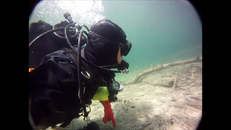Decide whether it is a stage/deco or pony bottle first. Tech philosophy does not always transition to rec diving.
A stage/deco bottle is not meant to be a "go to" air source in an OOA situation. It is meant for pre-planned routine gas switches so the valve can be turned off (there is no stress attached to the transition). In fact, the switch is very controlled and even involves reading the contents of the bottle, tracing the reg hose etc...
A pony bottle is meant to be an emergency air source for people who have an unplanned need for gas. In that case they/you may expect it to be working now. If you advertise your pony as an alternate air source it should be able to be breathed immediately, not after an intermediate step. Stress can also trigger irrational panic and even a diver who owns a pony can screw up if it doesn't work when he/she needs it. If it is a yoked reg, it is also possible to remove the first stage instead of turning on the air. That's a neat fix to do while holding your breath!
If it's just you, do what you want, but in the last month I have interceded in two adverse events surrounding ponies.
One, where a hose could not be deployed because of the way it was stowed. A long hose doubled up that caught around its own tail in the bungies.
The other, carried on the hip, could not even be accessed by the diver because of the silly velcro neck retaining strap system it had(some thing you undid and then unzipped to deploy the bottle from a bag so you could breath it like a spare air). The diver could not undo the velcro.
Both these were on training dives, but the second diver admitted that, if it had been for real, he would have be dead.
As for ponies draining themselves. Next dive purge your pony while diving and see how long and loud it takes to empty. This speaks of course, to where you mount it and how you monitor its contents. Mine is in my left armpit and the bubbles are quite easy to see.
View attachment 161665





